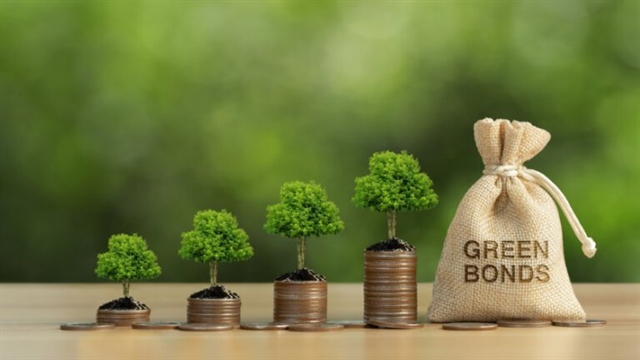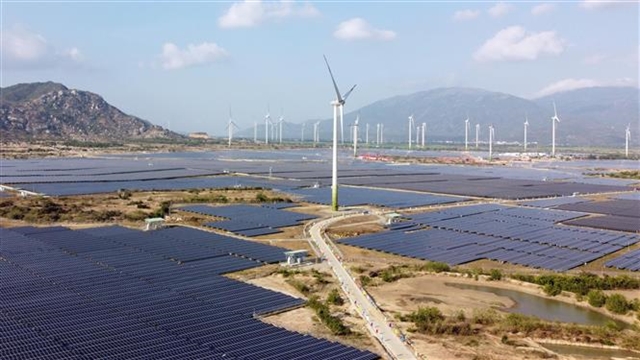Việt Nam's green bond market scales up, but standards are key for credibility
While the volume of issuances is growing, experts warn that the absence of a unified green taxonomy and clear certification standards could expose the market to mislabelling risks and ultimately harm its long-term credibility.

HÀ NỘI — Việt Nam's green bond market is gaining remarkable momentum, with the total value of issuances rising rapidly in the past two years.
As the country pursues its commitment to net zero emissions by 2050, green finance – particularly green bonds – is emerging as a key tool to fund climate-resilient infrastructure, renewable energy, and sustainable development.
However, while the volume of issuances is growing, experts warn that the absence of a unified green taxonomy and clear certification standards could expose the market to mislabelling risks and ultimately harm its long-term credibility.
According to data from the Vietnam Bond Market Association (VBMA), from 2021 to 2024, Vietnamese businesses issued more than US$1.4 billion in green bonds. These include both Government-led and private sector deals, with significant participation from renewable energy, water management, and sustainable agriculture firms.
In 2023 alone, the market recorded over VNĐ2.5 trillion ($96 million) in green bond issuance, and that figure surged to nearly VNĐ7 trillion in 2024, a 171 per cent year-on-year increase.
Private enterprises and local authorities alike have entered the green finance arena. Notable issuers include Trung Nam Solar Power, IDI International Development & Investment Corporation, Hoa Binh–Xuan Mai Clean Water and EVNFinance. On the public side, Bà Rịa – Vũng Tàu was among the pioneering provinces in the country to pilot green bond issuance to finance wastewater and clean water infrastructure.
The growth trajectory of Việt Nam’s green bond market is clear, but what’s more important now is ensuring the integrity of green qualification, head of Credit Risk Research and Sustainable Finance Services at FiinRatings Nguyễn Tùng Anh said at a recent virtual seminar themed 'Developing the Green Bond Market: Exploring Opportunities on the Path to Net Zero.'
In the long term, green bonds will become an implicit standard for companies aiming to access low-cost capital, but only if investors can trust that the money is being used for genuinely sustainable purposes, he added.
Green bonds have quickly gained popularity among foreign institutional investors, particularly from the US and Europe, many of whom are bound by environmental, social and governance (ESG) mandates.
According to FiinRatings, these bonds offer an attractive combination of relatively fixed interest rates, usually between 5.5 per cent and 6 per cent, and offer long tenors, making them particularly appealing to long-term, impact-driven capital pools.
The availability of this capital, however, hinges on transparency.
A central concern raised by industry experts and regulators is the absence of a national green taxonomy – a detailed classification system that clearly defines what activities qualify as green. Without it, companies could label any debt instrument as a green bond without being held accountable for the environmental performance of the financed projects.
"If we do not tighten definitions and enforce disclosure, we risk undermining investor trust and the very objective of green finance," Anh warned.

This concern is shared by Vũ Chí Dũng, director of International Cooperation at the SSC, who noted that although the legal framework for green bonds is largely in place, it needs more detailed guidance.
"From legal provisions to practical implementation, the market still lacks synchronised standards. We are working on it, but it will take time and coordination across ministries and sectors," he said.
Still, investor confidence appears to be strengthening.
Earlier this month, HDBank completed documentation for the issuance of up to $100 million in green bonds through two tranches, targeting institutional investors from the Netherlands and the US. These funds will be channelled toward projects aligned with the bank’s environmental and climate strategy.
According to the VBMA, green bonds are particularly well suited for financing long-term infrastructure projects — many of which fall outside traditional bank lending cycles.
"They not only mobilise resources but also encourage issuers to upgrade internal systems and ESG reporting standards," said Đỗ Ngọc Quỳnh, the association’s general secretary.
Despite their promise, green bonds still represent a small fraction of Việt Nam’s corporate bond market.
Many companies remain unfamiliar with green finance frameworks, while others are hesitant due to the added reporting burden and lack of immediate financial incentives.
However, with Việt Nam estimated to require at least $20 billion annually for its green transition, the Government and market participants are increasingly aligned in their recognition that green bonds will play a critical role.
To sustain this growth, market watchers say Việt Nam must act quickly to finalise its national green taxonomy, enforce disclosure regulations, and create incentives that reward genuine environmental impact.
As the market matures, these measures will be essential not only to maintain investor confidence but also to channel capital into projects that align with the country’s climate commitments. — BIZHUB/VNS





